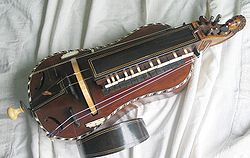Vielle à roue
 |
|
| Other names | Wheel fiddle, wheel vielle |
|---|---|
| Classification | String instrument (bowed) |
| Playing range | |
 |
|
| Related instruments | |
The hurdy-gurdy is a stringed instrument that produces sound by a hand crank-turned, rosined wheel rubbing against the strings. The wheel functions much like a violin bow, and single notes played on the instrument sound similar to those of a violin. Melodies are played on a keyboard that presses tangents—small wedges, typically made of wood—against one or more of the strings to change their pitch. Like most other acoustic stringed instruments, it has a sound board and hollow cavity to make the vibration of the strings audible.
Most hurdy-gurdies have multiple drone strings, which give a constant pitch accompaniment to the melody, resulting in a sound similar to that of bagpipes. For this reason, the hurdy-gurdy is often used interchangeably or along with bagpipes, particularly in Occitan, Catalan, Cajun French and contemporary Asturian, Cantabric, Galician, and Hungarian folk music.
Many folk music festivals in Europe feature music groups with hurdy-gurdy players. The most famous has been held since 1976 at Saint-Chartier in the Indre département in Central France. In 2009, it relocated nearby to the at La Châtre, where it continues to take place during the week nearest July 14 (Bastille Day).
The hurdy-gurdy is generally thought to have originated from fiddles in either Europe or the Middle East (e.g., the rebab instrument) some time before the eleventh century A.D. The first recorded reference to fiddles in Europe was in the 9th century by the Persian geographer Ibn Khurradadhbih (d. 911) describing the lira (lūrā) as a typical instrument within the Byzantine Empire. One of the earliest forms of the hurdy-gurdy was the organistrum, a large instrument with a guitar-shaped body and a long neck in which the keys were set (covering one diatonic octave). The organistrum had a single melody string and two drone strings, which ran over a common bridge, and a relatively small wheel. Due to its size, the organistrum was played by two people, one of whom turned the crank while the other pulled the keys upward. Pulling keys upward is cumbersome, so only slow tunes could be played on the organistrum.
...
Wikipedia
